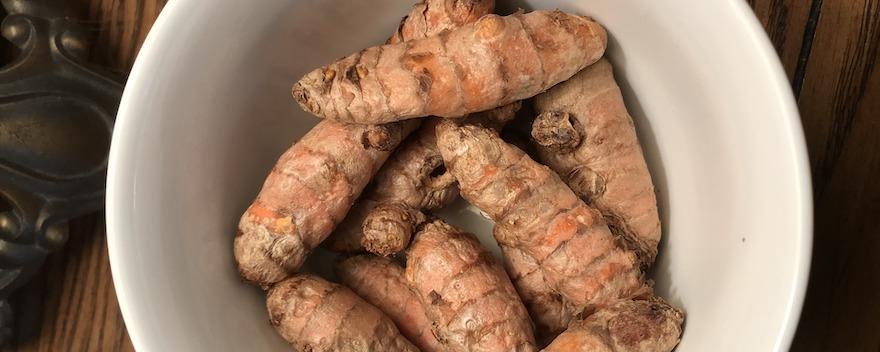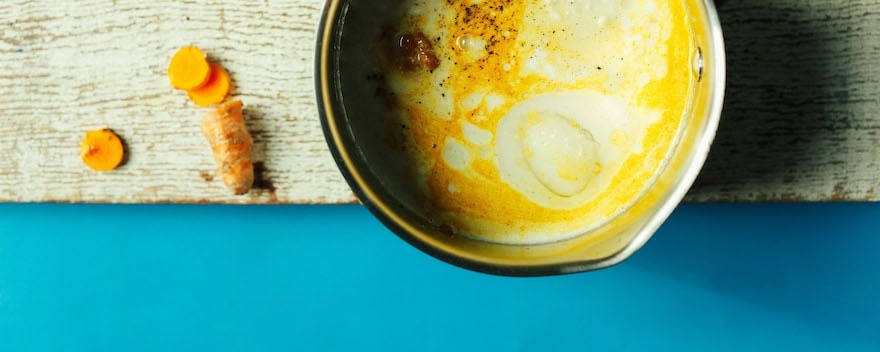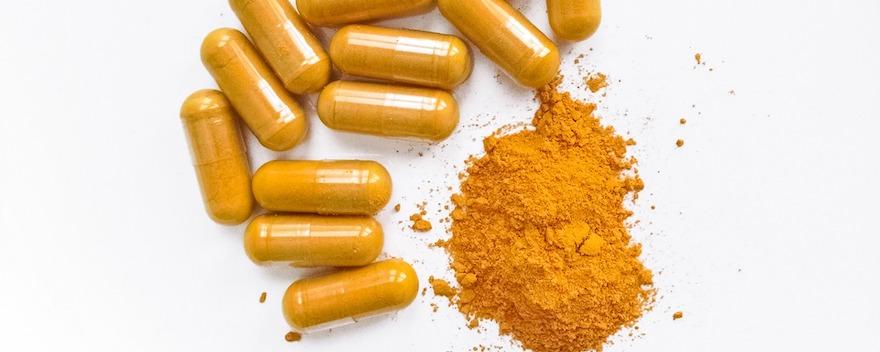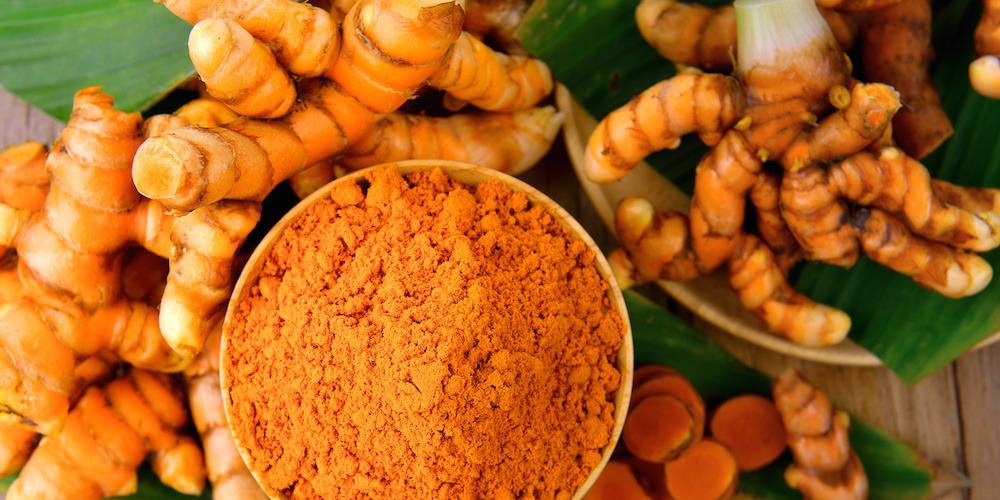VALIDATION SCIENTIFIQUE
Laure Fourchaud – 23.07.2021
Dr en physiologie de la nutrition
{{{TEMP_MARK_32}}}
What is turmeric?
Turmeric (curcuma longa) is a flowering plant originally growing in India and Southeast Asia, from the Zingiberaceae family like ginger and cardamom. The spice of the same name is obtained by grinding the rhizome – the underground stem of the plant.
Cultivated in India since antiquity, turmeric appears in the form of a stem that can reach up to 1m in height, growing on very fertile soil and sunny lands. There are 40 varieties of it. About 7 months after planting, the stem begins to dry out and the harvest can begin. Its rhizome is then ground and used in cooking as a food coloring and natural preservative.
But it is also consumed for therapeutic purposes in traditional Indian medicine or Ayurveda. It has numerous benefits, celebrated for centuries in Asia and now confirmed by science, including its anti-inflammatory, antioxidant, and detoxifying properties for the body.
Researchers are particularly studying it in the context of cancer prevention and treatment.

{{{TEMP_MARK_23}}}
The etymology of the name turmeric is as interesting as the virtues attributed to it! “Turmeric” comes from the Sanskrit kunkuma, ranjani meaning “that which gives color”. In English, it is called turmeric, derived from the French “terre mérite,” a term itself from the Latin terra merita referring to the earth around the root and its medicinal properties.
{{{TEMP_MARK_53}}}
{{{TEMP_MARK_60}}}

Nutritional Composition
-
{{{TEMP_MARK_123}}}
- Polyunsaturated fatty acids (including linoleic acid)
- Vitamins C, B3, B6, K
- Minerals and trace elements: calcium, iron, magnesium, phosphorus, potassium, sodium, zinc, copper, manganese, selenium
- Alkaloids
- Polyphenolic pigment: curcumin
Benefits
🌵 Anti-inflammatory
It is the anti-inflammatory properties of turmeric that make it a key element in Ayurvedic medicine and traditional Chinese medicine, thanks to its high curcumin content.
It is especially effective in fighting chronic inflammatory diseases, arthritis, irritable bowel syndrome, ulcerative colitis, Crohn’s disease, post-operative edema, eye infections, gingivitis.
Its anti-inflammatory virtues make it a real ally against osteoarthritis and help protect joints.
Also read Turmeric, a natural remedy against osteoarthritis
It is established that it acts at the molecular level, by blocking NF-kB, a protein that activates inflammatory reactions within our cells. It has the advantage of being a natural anti-inflammatory, sometimes as potent as certain medications, without side effects.
Scientific Studies:
- This study from the University of California at San Francisco demonstrates the anti-inflammatory activity of curcumin found in turmeric, inhibiting the molecules responsible for inflammation.
- This one, conducted by the University of Reading in the UK on 500 volunteers suggests improvement in symptoms of irritable bowel syndrome.
💎 Detoxifies the liver and improves digestion
{{{TEMP_MARK_3}}}
The effectiveness of turmeric is recognized by the WHO and the Commission E, a German scientific advisory board on the use of phytomedicines, for treating various digestive disorders such as nausea, stomach aches, bloating, diarrhea…
Furthermore, it improves digestion and transit by regulating the intestinal flora. As such, it is a true preventive measure against gastric ulcers.
Scientific Studies:
- This study conducted by the hepatology department of the University of Düsseldorf shows that combined with greater celandine, turmeric helps relieve liver pain.
- This clinical trial conducted in Thailand shows that consuming turmeric helps effectively reduce digestive issues.
🥝 Antioxidant
Turmeric is one of the most antioxidant foods, due to curcumin and its potent antioxidant effects. It neutralizes free radicals responsible for cellular aging.
{{{TEMP_MARK_63}}}
Scientific Studies:
-
{{{TEMP_MARK_30}}}
{{{TEMP_MARK_33}}}
🧘🏻♀️ Contributes to better nervous balance
Turmeric acts as a natural anti-stress agent and helps to reduce anxiety.
Curcumin is found to be an ally in helping combat depression. It may increase our serotonin levels (a neurotransmitter responsible for happiness) and dopamine (associated with pleasure and reward).
Scientific Studies:
- This study, conducted by the Gujarat Government Medical College in India on a sample of 60 people, demonstrated that consumption of curcumin (1000 mg) was as effective as prozac (20 mg) in treating depression. However, these promising initial clinical results need to be confirmed
- This preclinical study conducted by Panjab University in India shows that curcumin helps to stimulate serotonin and dopamine.
🔬 Potentially “anti-cancer”
{{{TEMP_MARK_36}}}
Curcumin and its anti-inflammatory and antioxidant effects reduce the risk of cancer occurrence. It may also aid its treatment by helping our body produce enzymes that block cancer cells.
It may be particularly effective in preventing cancers related to the digestive system (colon, stomach, liver, esophagus…).
Scientific Studies:
- This study from the University of Illinois in Chicago conducted on 44 men with potentially cancerous colon lesions shows that daily use of 4g of curcumin for 30 days reduces the number of lesions by 40%.
- This one, summarizes scientific data on the various mechanisms by which curcumin could help eliminate cancer cells and reduce angiogenesis (new blood vessel growth in tumors).
{{{TEMP_MARK_73}}}
Turmeric beneficially affects the vascular endothelium, the inner layer of our blood vessels, directly in contact with blood. Its degradation is often implicated in the onset of cardiovascular diseases.
Curcumin, with its blood-thinning properties, helps to regulate blood pressure and coagulation. It is also a valuable ally for improving circulation.
Its antioxidant and anti-inflammatory properties also help limit the onset of cardiovascular diseases.
Scientific Studies:
This study by the Department of Medicine at Chiang Mai University in Thailand, conducted on 121 patients undergoing coronary bypass, establishes that the consumption of curcumin helps to lower the risk of cardiovascular events.

Expert Opinion
Turmeric is the star spice of Indian cuisine and Ayurvedic medicine. It is attributed with many virtues, some of which are now supported by quality scientific studies. Notably, its curcumin content gives it its antioxidant, anti-inflammatory effects, and many others.
💡Therapeutic use: To benefit from the therapeutic effects of turmeric, adding a pinch to your dish is not enough. Indeed, the doses at which effects appear are higher than the doses used in cooking. For therapeutic purposes, a dietary supplement combining curcumin and piperine (a substance from pepper) is ideal, especially if taken with a meal containing good fats. However, due to potential drug interactions, especially with anticoagulants, always consult your doctor before starting a course.
💡Avoid fraudulent products: With its rise in popularity, turmeric, like many imported spices, is regularly subject to fraud (41% of anomalies identified for turmeric during the latest quality control campaign of spices by the DGCCRF). To avoid fraud, it is best to carefully choose the products you buy: preferably select organic turmeric, labeled to allow product traceability.
Perrine Bellanger – dietitian nutritionist
{{{TEMP_MARK_93}}}

Favor organic turmeric
{{{TEMP_MARK_37}}}
You can easily find organic turmeric powder, fresh, and in capsules at organic stores, but increasingly in supermarkets.
Fresh turmeric
{{{TEMP_MARK_13}}}
Also read | Discover fresh turmeric: its use, preservation, and the best recipes
Simply ensure its skin is in good condition, then peel it, cut it into small pieces, or grate it like ginger, and cook if needed.
Be careful when handling it, it is very staining, and you can quickly end up with stained fingers!
Turmeric powder
{{{TEMP_MARK_34}}}
You can add it to dishes before and after cooking, in detox smoothies, or infuse it.
In recent years, the beautifully named Golden Milk or Golden Milk has been a resounding success: a mix of plant-based milk (almond or oat), coconut oil, and turmeric. Apart from being delicious and healthy, it’s very photogenic, as proven by thousands of Instagram posts about it!

{{{TEMP_MARK_103}}}
This non-culinary use of turmeric as a dietary supplement may seem strange, but it has the advantage of allowing precise dosage and long-term treatment. Turmeric capsules are often made with concentrated extracts, resulting in a very high curcumin content.
Combine turmeric with piperine
The only downside of curcumin, which is responsible for many of turmeric’s benefits, is its low absorption capacity by the body. It is not water-soluble. To gain the most benefits from turmeric, it is recommended to consume it with foods that will bind the curcumin, especially piperine.
Piperine, a spicy alkaloid found in black pepper, allows better absorption of curcumin in our body (up to 20 times more). Therefore, combining turmeric with black pepper is the best way to enjoy its benefits.
A small amount, such as 1 mg of black pepper for 100 mg of turmeric, is sufficient.
Combine turmeric with oil
Curcumin is liposoluble, meaning it dissolves in fats. Olive and coconut oils contribute to better bioavailability of curcumin and better absorption by our body.
Turmeric Recipes

One of the advantages of turmeric is that it is very easy to cook and delicately flavors dishes, not to mention giving them a wonderful color. It is found in many recipes for saucy dishes, legumes, and meats.
Dosage
⚖️ It is not easy to consume turmeric in large quantities daily, but high doses are recommended to make the most of its properties. What dosage to adopt according to the benefits sought?
🥄 Basic daily regimen: 3 g of powder/day
💊 Turmeric extract to treat inflammation or a more specific digestive issue (high curcumin content capsule): 1.2 to 1.7 g per day
Contraindications and side effects
{{{TEMP_MARK_38}}}
{{{TEMP_MARK_83}}}
Read also | Is turmeric dangerous for health?
It is contraindicated for people:
- suffering from gallstones
- with liver diseases, stomach ulcers
- showing signs of allergy to turmeric
- on anticoagulants, as the blood-thinning properties of turmeric can add to the medication
Moreover, at excessive doses, the following side effects may occur:
- dry mouth
- heartburn
{{{TEMP_MARK_132}}}
History and current culture
Turmeric has been cultivated for over two thousand years in India. It is mentioned in Sanskrit texts from the 4th century BC. The Atharva-Veda, a sacred text of ancient India, mentions turmeric and its therapeutic uses, particularly its benefits against heart diseases.
Its use is also listed in China since the 7th century BC, and in the West since antiquity, but it has been mainly imported to Europe since the 18th century. It is now produced worldwide, from Myanmar to Réunion Island and South America.
Nevertheless, its leading global producer, consumer, and exporter remains India, with a production of about 1.5 million tons per year.
Read also | On the road of super foods in Myanmar
{{{TEMP_MARK_31}}}
Detailed Nutritional Values
This data has been synthesized and verified for Darwin Nutrition by Laure Fourchaud, Doctor in Nutrition Physiology.
| Turmeric powder | {{{TEMP_MARK_133}}} | {{{TEMP_MARK_134}}} | {{{TEMP_MARK_131}}} | {{{TEMP_MARK_135}}} |
| Energy (kcal) | {{{TEMP_MARK_232}}} | 17.7 | 17.7 | 0.88 |
| Fibers (g) | 21.1 | 70.33 | 1.05 | 3.51 |
| Water (g) | 11.36 | 0.56 | ||
| Macronutrients | ||||
| {{{TEMP_MARK_153}}} | 7.83 | 15.66 | 0.39 | 0.78 |
| Carbohydrates (g) | 64.9 | 24.96 | {{{TEMP_MARK_{{{TEMP_MARK_236}}}}}} | 1.25 |
| of which Sugars (g) | 3.21 | 3.56 | 0.16 | 0.18 |
| Fats (g) | 9.88 | 14.11 | 0.49 | {{{TEMP_MARK_233}}} |
| Minerals | ||||
| Calcium (mg) | {{{TEMP_MARK_234}}} | {{{TEMP_MARK_173}}} | 9.15 | 1.14 |
| Iron (mg) | 41.42 | |||
| Copper (mg) | {{{TEMP_MARK_235}}} | 60 | {{{TEMP_MARK_203}}} | 3 |
| Magnesium (mg) | {{{TEMP_MARK_236}}} | 51.46 | 9.65 | {{{TEMP_MARK_237}}} |
| Manganese (mg) | 7.83 | 391.5 | 0.39 | 19.57 |
| Phosphorus (mg) | {{{TEMP_MARK_238}}} | 38.28 | 13.4 | 1.91 |
| Potassium (mg) | 2525 | 126.25 | 126.25 | {{{TEMP_MARK_239}}} |
| Sodium (mg) | 38 | 1.52 | 1.9 | 0.08 |
| {{{TEMP_MARK_163}}} | ||||
| {{{TEMP_MARK_160}}} | 4.35 | {{{TEMP_MARK_213}}} | 0.21 | 2.17 |
| {{{TEMP_MARK_130}}} | ||||
| Vitamin A (mg) | {{{TEMP_MARK_243}}} | {{{TEMP_MARK_243}}} | {{{TEMP_MARK_243}}} | {{{TEMP_MARK_243}}} |
| Vitamin C (mg) | 25.9 | 32.37 | 1.29 | 1.62 |
| Vitamin E (mg) | {{{TEMP_MARK_243}}} | {{{TEMP_MARK_243}}} | {{{TEMP_MARK_243}}} | {{{TEMP_MARK_243}}} |
| {{{TEMP_MARK_138}}} | 0.15 | 13.64 | 0.01 | 0.68 |
| {{{TEMP_MARK_139}}} | 0.23 | 16.43 | 0.01 | 0.82 |
| Vitamin B3 (mg) | {{{TEMP_MARK_243}}} | {{{TEMP_MARK_243}}} | {{{TEMP_MARK_243}}} | {{{TEMP_MARK_243}}} |
| Vitamin B5 (mg) | {{{TEMP_MARK_243}}} | {{{TEMP_MARK_243}}} | {{{TEMP_MARK_243}}} | {{{TEMP_MARK_243}}} |
| Vitamin B6 (mg) | 1.8 | {{{TEMP_MARK_243}}} | {{{TEMP_MARK_243}}} | {{{TEMP_MARK_243}}} |
| Vitamin B9 or folates (μg) | 39 | 19.5 | 1.95 | 0.97 |
| {{{TEMP_MARK_143}}} | 13.4 | 17.86 | {{{TEMP_MARK_230}}} | {{{TEMP_MARK_231}}} |
*%RI: % Reference intake for an adult
Other antioxidant compounds: flavonoids, phenolic compounds and curcumin
Sources and scientific studies
Chainani-Wu N, 2003. Safety and anti-inflammatory activity of curcumin: a component of tumeric (Curcuma longa).
Bundy R, Walker AF, Middleton RW, Booth J, 2004. Turmeric extract may improve irritable bowel syndrome symptomology in otherwise healthy adults: a pilot study.
Niederau C, Göpfert E, 1999. [The effect of chelidonium- and turmeric root extract on upper abdominal pain due to functional disorders of the biliary system. Results from a placebo-controlled double-blind study].
Thamlikitkul V, Bunyapraphatsara N, Dechatiwongse T, Theerapong S, Chantrakul C, Thanaveerasuwan T, Nimitnon S, Boonroj P, Punkrut W, Gingsungneon V, 1999. Randomized double blind study of Curcuma domestica Val. for dyspepsia.
Barclay LR, Vinqvist MR, Mukai K, Goto H, Hashimoto Y, Tokunaga A, Uno H, 2000. On the antioxidant mechanism of curcumin: classical methods are needed to determine antioxidant mechanism and activity.
Menon VP, Sudheer AR, 2007. Antioxidant and anti-inflammatory properties of curcumin.
Sanmukhani J, Satodia V, Trivedi J, Patel T, Tiwari D, Panchal B, Goel A, Tripathi CB, 2014. Efficacy and safety of curcumin in major depressive disorder: a randomized controlled trial.
Shrinivas K. Kulkarni, Mohit Kumar Bhutani & Mahendra Bishnoi, 2008. Antidepressant activity of curcumin: involvement of serotonin and dopamine system.
Carroll RE, Benya RV, Turgeon DK, Vareed S, Neuman M, Rodriguez L, Kakarala M, Carpenter PM, McLaren C, Meyskens FL Jr, Brenner DE, 2011. Phase IIa clinical trial of curcumin for the prevention of colorectal neoplasia.
Jayaraj Ravindran, Sahdeo Prasad, and Bharat B. Aggarwal, 2009. Curcumin and Cancer Cells: How Many Ways Can Curry Kill Tumor Cells Selectively?
Wongcharoen W, Jai-Aue S, Phrommintikul A, Nawarawong W, Woragidpoonpol S, Tepsuwan T, Sukonthasarn A, Apaijai N, Chattipakorn N, 2012. Effects of curcuminoids on frequency of acute myocardial infarction after coronary artery bypass grafting.
R. R. Kulkarni and others, ‘Treatment of Osteoarthritis with a Herbomineral Formulation: A Double-Blind, Placebo-Controlled, Cross-over Study’, Journal of Ethnopharmacology, 33.1–2 (1991), 91–95.
{{{TEMP_MARK_43}}}
{{{TEMP_MARK_35}}}
Julie S Jurenka. Anti-inflammatory properties of curcumin, a major constituent of Curcuma longa: a review of pre-clinical and clinical research. Alternative Medicine Review: A Journal of Clinical Therapeutic, 14.2 (2009), 141 – 53.



